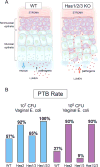Cervical hyaluronan biology in pregnancy, parturition and preterm birth
- PMID: 29510230
- PMCID: PMC6120812
- DOI: 10.1016/j.matbio.2018.03.002
Cervical hyaluronan biology in pregnancy, parturition and preterm birth
Abstract
Cervical hyaluronan (HA) synthesis is robustly induced in late pregnancy in numerous species including women and mice. Recent evidence highlights the diverse and dynamic functions of HA in cervical biology that stem from its expression in the cervical stroma, epithelia and immune cells, changes in HA molecular weight and cell specific expression of HA binding partners. Mice deficient in HA in the lower reproductive tract confirm a structural role of HA to increase spacing and disorganization of fibrillar collagen, though this function is not critical for pregnancy and parturition. In addition, cervical HA depletion via targeted deletion of HA synthase genes, disrupts cell signaling required for the differentiation of epithelia and their mucosal and junctional barrier, resulting in increased susceptibility to ascending infection-mediated preterm birth. Finally the generation of HA disaccharides by bacterial hyaluronidases as made by Group B streptococcus can ligate toll like receptors TLR2/4 thus preventing appropriate inflammatory responses as needed to fight ascending infection and preterm birth. This review summarizes our current understanding of HA's novel and unique roles in cervical remodeling in the process of birth.
Keywords: Ascending infection; Cervical ripening; Cervix; Hyaluronan; Parturition; Preterm birth.
Copyright © 2018 Elsevier B.V. All rights reserved.
Figures


Similar articles
-
Dynamic changes in cervical glycosaminoglycan composition during normal pregnancy and preterm birth.Endocrinology. 2012 Jul;153(7):3493-503. doi: 10.1210/en.2011-1950. Epub 2012 Apr 23. Endocrinology. 2012. PMID: 22529214 Free PMC article.
-
Hyaluronan in cervical epithelia protects against infection-mediated preterm birth.J Clin Invest. 2014 Dec;124(12):5481-9. doi: 10.1172/JCI78765. Epub 2014 Nov 10. J Clin Invest. 2014. PMID: 25384213 Free PMC article.
-
Hyaluronan and its binding proteins during cervical ripening and parturition: dynamic changes in size, distribution and temporal sequence.Matrix Biol. 2008 Jun;27(5):487-97. doi: 10.1016/j.matbio.2008.01.010. Epub 2008 Mar 18. Matrix Biol. 2008. PMID: 18353623 Free PMC article.
-
Distinct Roles of Cervical Epithelia and Stroma in Pregnancy and Parturition.Semin Reprod Med. 2017 Mar;35(2):190-200. doi: 10.1055/s-0037-1599091. Epub 2017 Mar 9. Semin Reprod Med. 2017. PMID: 28278536 Review.
-
Cervical remodeling during pregnancy and parturition.Trends Endocrinol Metab. 2010 Jun;21(6):353-61. doi: 10.1016/j.tem.2010.01.011. Epub 2010 Feb 19. Trends Endocrinol Metab. 2010. PMID: 20172738 Free PMC article. Review.
Cited by
-
Bacterial and Host Determinants of Group B Streptococcal Vaginal Colonization and Ascending Infection in Pregnancy.Front Cell Infect Microbiol. 2021 Sep 3;11:720789. doi: 10.3389/fcimb.2021.720789. eCollection 2021. Front Cell Infect Microbiol. 2021. PMID: 34540718 Free PMC article. Review.
-
Vaginal Microbiome: Environmental, Biological, and Racial Influences on Gynecological Health Across the Lifespan.Am J Reprod Immunol. 2024 Dec;92(6):e70026. doi: 10.1111/aji.70026. Am J Reprod Immunol. 2024. PMID: 39670915 Free PMC article. Review.
-
Effector and Activated T Cells Induce Preterm Labor and Birth That Is Prevented by Treatment with Progesterone.J Immunol. 2019 May 1;202(9):2585-2608. doi: 10.4049/jimmunol.1801350. Epub 2019 Mar 27. J Immunol. 2019. PMID: 30918041 Free PMC article. Clinical Trial.
-
The Association of High-Molecular-Weight Hyaluronic Acid (HMWHA), Alpha Lipoic Acid (ALA), Magnesium, Vitamin B6, and Vitamin D Improves Subchorionic Hematoma Resorption in Women with Threatened Miscarriage: A Pilot Clinical Study.J Clin Med. 2024 Jan 25;13(3):706. doi: 10.3390/jcm13030706. J Clin Med. 2024. PMID: 38337402 Free PMC article.
-
Shear wave dispersion as a potential biomarker for cervical remodeling during pregnancy: evidence from a non-human primate model.Front Phys. 2021 Feb;8:606664. doi: 10.3389/fphy.2020.606664. Epub 2021 Feb 15. Front Phys. 2021. PMID: 34178971 Free PMC article.
References
-
- Russell DL, Salustri A. Extracellular matrix of the cumulus-oocyte complex. Semin Reprod Med. 2006;24(4):217–27. - PubMed
-
- Salustri A, Yanagishita M, Hascall VC. Synthesis and accumulation of hyaluronic acid and proteoglycans in the mouse cumulus cell-oocyte complex during follicle-stimulating hormone-induced mucification. J Biol Chem. 1989;264(23):13840–7. - PubMed
-
- Salustri A, Campagnolo L, Klinger FG, Camaioni A. Molecular organization and mechanical properties of the hyaluronan matrix surrounding the mammalian oocyte. Matrix Biol. 2018 - PubMed
-
- Skinner SJ, Liggins GC. Glycosaminoglycans and collagen in human amnion from pregnancies with and without premature rupture of the membranes. Journal of developmental physiology. 1981;3(2):111–21. - PubMed
-
- Danforth DN. The fibrous nature of the human cervix, and its relation to the isthmic segment in gravid and nongravid uteri. Am J Obstet Gynecol. 1947;53(4):541–60. - PubMed
Publication types
MeSH terms
Substances
Grants and funding
LinkOut - more resources
Full Text Sources
Other Literature Sources

